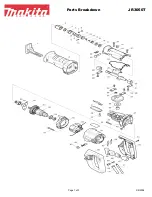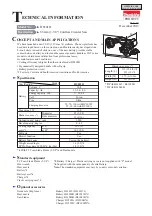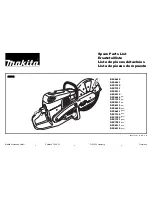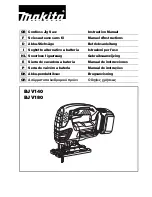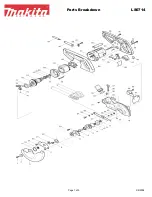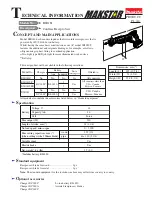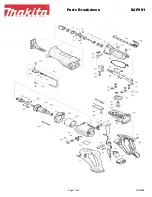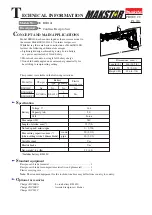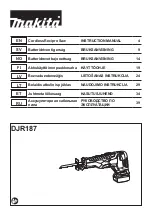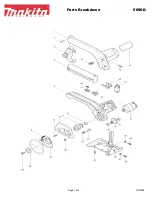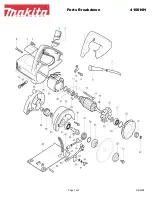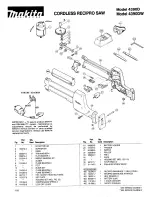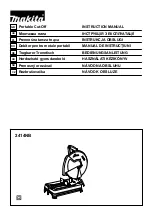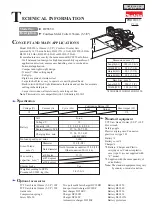
ENGLISH
43
Lower Guard Safety Instructions
a)
Check lower guard for proper closing before
each use. Do not operate the saw if lower
guard does not move freely and close
instantly. Never clamp or tie the lower guard
into the open position.
If saw is accidentally
dropped, lower guard may be bent. Raise the
lower guard with the retracting handle and
make sure it moves freely and does not touch
the blade or any other part, in all angles and
depths of cut.
b)
Check the operation of the lower guard
spring. If the guard and the spring are not
operating properly, they must be serviced
before use.
Lower guard may operate
sluggishly due to damaged parts, gummy
deposits, or a build-up of debris.
c)
Lower guard should be retracted manually
only for special cuts such as “plunge cuts”
and “compound cuts.” Raise lower guard
by retracting handle and as soon as blade
enters the material, the lower guard must be
released.
For all other sawing, the lower guard
should operate automatically.
d)
Always observe that the lower guard is
covering the blade before placing saw down
on bench or floor.
An unprotected, coasting
blade will cause the saw to walk backwards,
cutting whatever is in its path. Be aware of the
time it takes for the blade to stop after switch is
released.
NOTE:
Although the above information references
wood, this saw is only to be used to cut metal.
Kickback can occur when cutting metal.
Additional Specifi c Safety
Instructions for Circular Saws
•
Do not use abrasive wheels or blades.
•
Do not use water feed attachments.
•
Do not attempt to cut stainless steel, rebar,
hardened or heat-treated steel, cast iron,
masonry or unknown materials
•
Use clamps or another practical way to
secure and support the workpiece to a
stable platform
. Holding the work by hand or
against your body leaves it unstable and may
lead to loss of control.
• Keep your body positioned to either side
of the blade, but not in line with the saw
blade.
KICKBACK could cause the saw to
jump backwards (see
Causes and Operator
Prevention of Kickback
and
KICKBACK
).
•
Air vents often cover moving parts and
should be avoided.
Loose clothes, jewellery or
long hair can be caught in moving parts.
•
Wear ear protectors.
Exposure to noise can
cause hearing loss.
• Wear a dust mask.
Exposure to dust particles
can cause breathing difficulty and possible
injury.
• Do not use blades of larger or smaller
diameter than recommended.
For the proper
blade rating refer to the
Technical Data
.
Use only the blades specified in this manual,
complying with EN 847-1.
• When not in use, place circular saw on a
stable surface, shoe side down, where it will
not cause a tripping or falling hazard.
Some
tools with large battery packs will stand upright
on the battery pack but may be easily knocked
over.
Residual Risks
The following risks are inherent to the use of circular
saws.
– Injuries caused by touching the rotating parts or
hot part of the tool.
In spite of the application of the relevant safety
regulations and the implementation of safety
devices, certain residual risks cannot be avoided.
These are:
– Impairment of hearing.
– Risk of squeezing fingers when changing the
accessory.
– Health hazards caused by breathing dust
developed when working in wood.
Markings on Tool
The following pictograms are shown on the tool:
Read instruction manual before use.
Wear ear protection.
Wear eye protection.
DATE CODE POSITION (FIG. 1)
The date code (u), which also includes
the year of
manufacture, is printed into the housing surface that
forms the mounting joint between tool and battery.
Содержание DCS373
Страница 1: ...DCS373 www eu ...
Страница 3: ...1 Figure 1 Figure 2 a b c e d l f h i g j k m d e i m Figure 3 u n o i ...
Страница 4: ...2 Figure 6 Figure 4 f r t q f r q s p Figure 5 q r f s t ...
Страница 5: ...3 Figure 8 Figure 7 Figure 9 d c A B d 13 mm 1 2 ...
Страница 6: ...4 Figure 10 Figure 11 o n ...
Страница 225: ...223 ...
Страница 226: ...224 ...
Страница 227: ...225 ...































